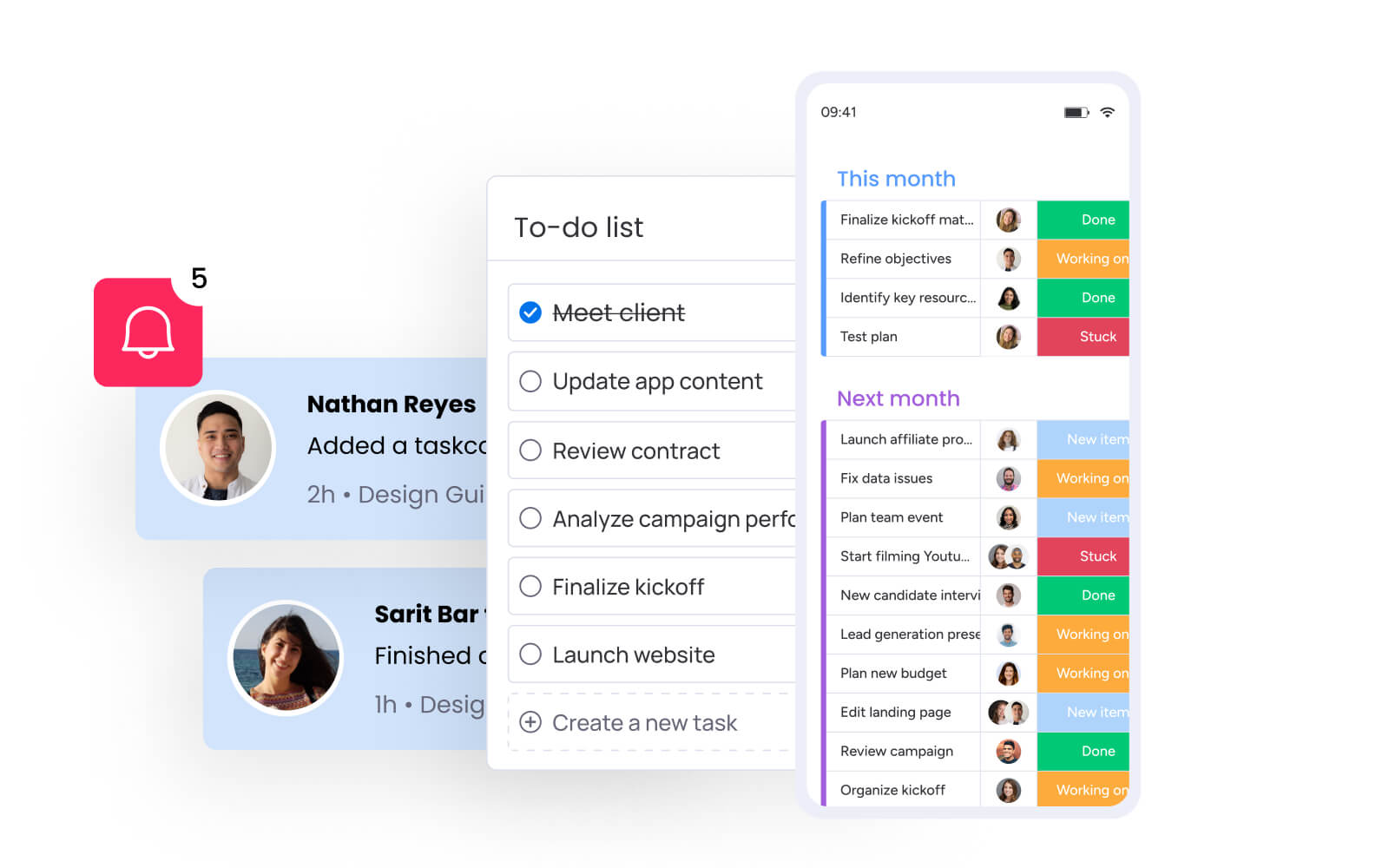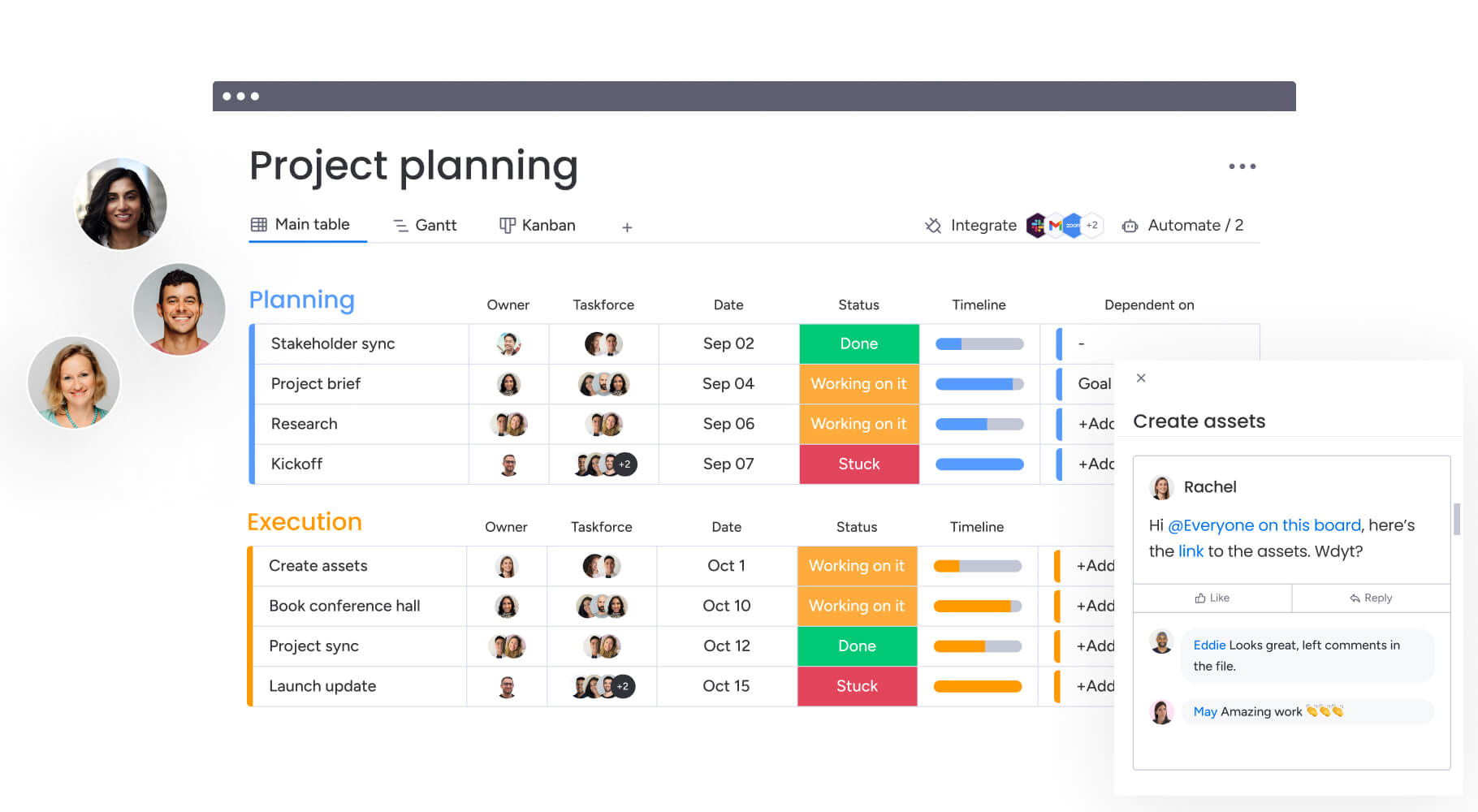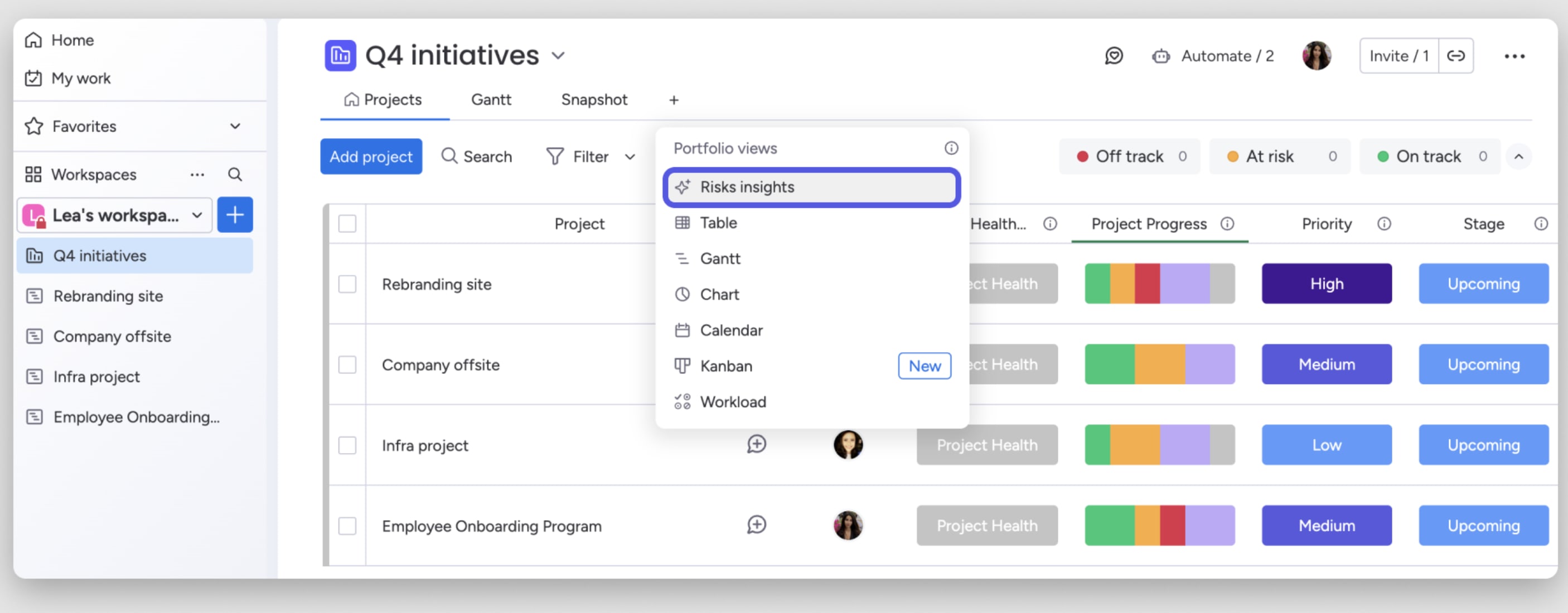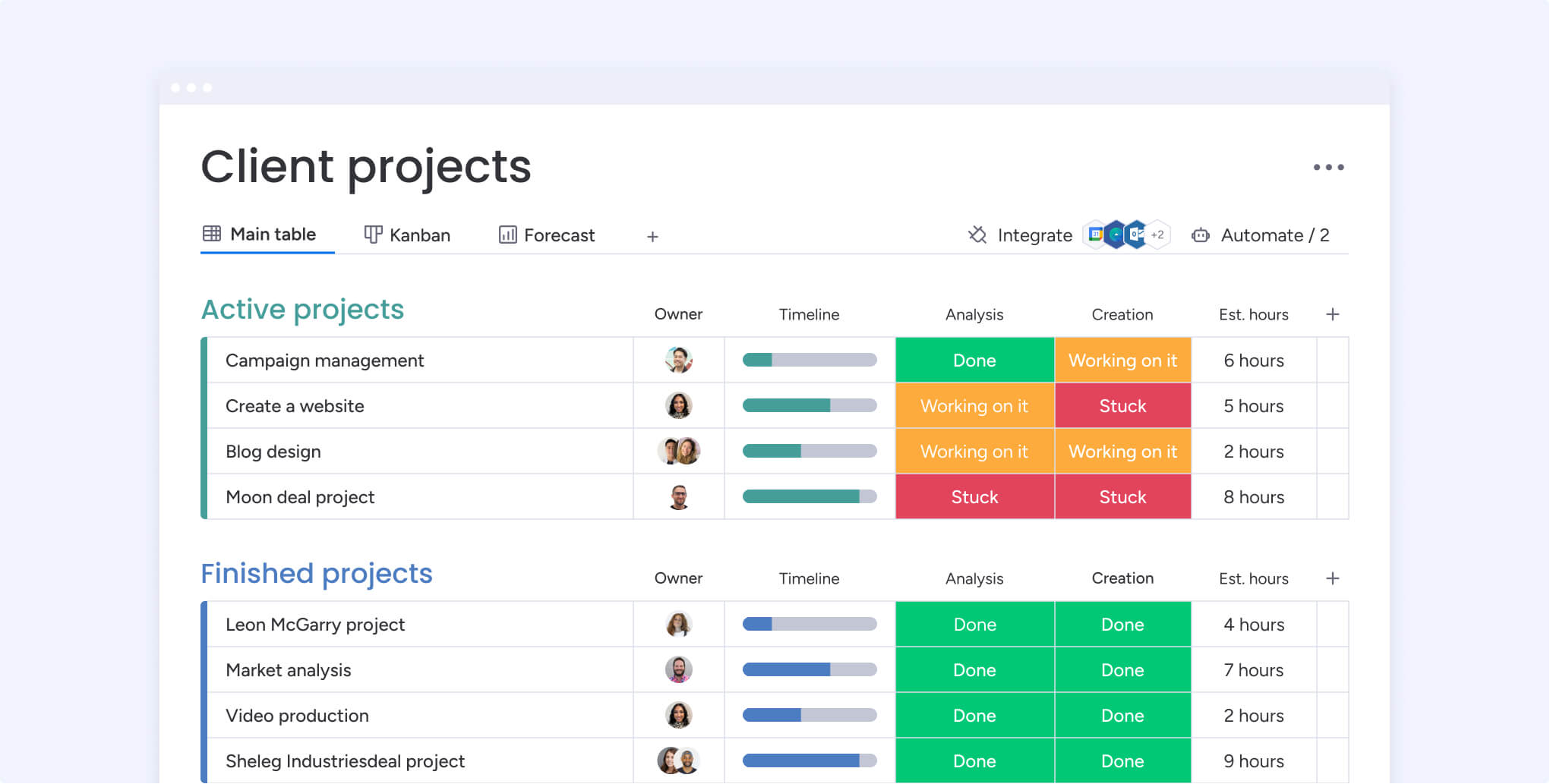Gold plating can sneak into even the most organized projects. A designer adds a flourish they think will impress the client, or a developer builds a feature “just in case it helps.” The intention is good — but the impact often isn’t. Extra work that falls outside the approved scope creates confusion, delays decisions, and adds pressure to teams already working to tight deadlines.
As project management becomes more fast-paced in 2026, staying disciplined about scope is more important than ever. Clear expectations, consistent communication, and the right checks in place can help teams stay focused on what truly matters.
This article walks through what gold plating looks like in practice, why it happens, the risks it brings, and the most reliable ways to avoid it. Along the way, you’ll see how platforms like monday work management keep project boundaries visible so your team can deliver exactly what was promised — no more, no less.
Key takeaways
Gold plating defined: adding unapproved features or enhancements that fall outside the agreed project scope.
Root causes: unclear requirements, pressure to impress, and misaligned assumptions often lead teams to add work that wasn’t requested.
Real risks: extra work can delay timelines, inflate budgets, and weaken client trust.
How to avoid it: strong scope documentation, open communication, and a consistent change process keep projects focused.
Visibility matters: platforms like monday work management helps teams track scope, manage change requests, and maintain alignment throughout the project.

What is gold plating?
Gold plating happens when a team adds work, features, or enhancements that weren’t part of the agreed project scope. These additions often come from good intentions — a desire to elevate the final product, fill leftover time, or show initiative. The challenge is that none of this extra effort is approved, which means the project quietly moves beyond its defined boundaries.
In many teams, gold plating slips in through small decisions: polishing a deliverable far beyond what was requested, expanding a task because “it could be helpful,” or building something the client never asked for. Those choices may seem minor, but they can introduce new complexity and disrupt the original plan.
Key signs to watch for include:
Unapproved additions: extra design elements, features, or functionality that weren’t documented in the scope.
Assumed value: team members believe the client will welcome the added work without checking first.
Shifting effort: time and resources move toward tasks that don’t directly support the project goals.
Gradual scope drift: small enhancements compound and affect timelines, budgets, or downstream work.
Understanding these patterns makes it easier to spot gold plating early and keep projects focused on the outcomes that were actually agreed on.
What causes gold plating?
Unapproved additions rarely happen out of nowhere. They usually stem from patterns in team culture, communication gaps, or unclear expectations that make it easy for extra work to slip in. Understanding the underlying causes helps you address them before they turn into costly scope issues.
Here are the most common drivers:
Vague or incomplete requirements: when the scope isn’t specific enough, team members may fill in the gaps based on personal interpretation rather than confirmed needs.
Pressure to impress: some teams feel compelled to “over-deliver,” especially when trying to build trust with a new client or demonstrate craftsmanship.
Unused time or budget: if a project is ahead of schedule or under budget, teams may assume they should spend those remaining resources by expanding the work.
Personal preferences or craftsmanship: individuals may polish or enhance work simply because they take pride in their skills, even if the client never asked for it.
Lack of guardrails: without a structured change process, it’s easy for well-intentioned ideas to turn into approved-by-default extras that go unnoticed until later.
Each of these factors opens the door to work that drifts away from the original plan, making it harder to maintain alignment and predictable delivery.
Gold plating vs scope creep and how they differ
Projects can drift off course in more than one way, and two of the most common culprits are gold plating and scope creep. They’re often mentioned together because both introduce work that wasn’t part of the original plan, but the reasons behind them — and the way they show up — are very different. Knowing which one you’re dealing with makes it easier to keep expectations, timelines, and deliverables on track.
In the case of gold plating, the extra work comes from inside the team. Someone decides to enhance a feature or add something they believe will elevate the final result, even though it wasn’t requested or approved. Scope creep emerges from the opposite direction: clients or stakeholders begin asking for additional features, revisions, or changes as the project progresses, sometimes without formally adjusting scope, budget, or timelines.
Both situations can disrupt momentum and create uncertainty. The comparison below outlines the main differences so you can quickly recognize the source of the issue and respond with the right process.
| Aspect | Gold plating | Scope creep |
|---|---|---|
| Source | Internal (Project team or manager) | External (Client or stakeholder) |
| Motivation | Attempting to exceed expectations or add perceived value | Changing requirements or new requests from the client |
| Approval | Unauthorized and not approved by the client | Requested by the client but often not formally managed |
| Impact | Wastes internal resources, can cause delays, may not align with client needs | Increases workload, strains resources, can lead to budget and timeline overruns |

Real-world examples of gold plating
Now that the difference between gold plating and scope creep is clearer, it’s easier to spot how gold plating appears in everyday work. It often starts as a small creative decision or an attempt to “add a little extra,” but those extras can create more problems than value. These examples show how it plays out across different types of projects.
Website and digital projects
A client might ask for a simple, minimal homepage. During the build, a developer adds animated transitions because they feel the site could use more personality. When the client sees the preview, the animations feel off-brand and slow down the page, forcing the team to remove them and re-test the work.
Software and product development
A developer finishes a feature early and decides to extend it with an extra configuration option. While the idea feels small and harmless, the additional logic introduces new bugs that weren’t part of the original testing plan. The added complexity ends up delaying quality assurance and pushing back the release.
Marketing and creative work
Teams producing presentations, reports, or campaign assets sometimes run into the same issue. A client might request clean, text-only slides, but the project manager adds polished imagery and graphics to “enhance the story.” The client rejects the visuals because they conflict with brand guidelines, leading to last-minute corrections.
Design and prototyping
In early design phases, it’s common for designers to refine components beyond what was requested. Instead of using the approved icon set, they create custom illustrations to elevate the aesthetic. These flourishes take longer to produce, don’t align with the brand system, and require reshaping later in the process.
Construction and physical projects
Gold plating isn’t limited to digital work. A contractor might swap standard materials for premium ones, assuming the client will be pleased with an upgrade. Instead, the client asks for the original specification to maintain consistency with the rest of the build, causing issues with project budget planning and scheduling.
These examples highlight a consistent theme: even when the intention is positive, unapproved improvements introduce new risks, extra work, and misalignment. The safest path is always to confirm value before adding it.

Practical ways to avoid gold plating in your projects
Avoiding gold plating isn’t about limiting creativity — it’s about keeping work aligned with what was approved so timelines, budgets, and expectations stay predictable. These eight practices help teams stay focused and prevent unrequested extras from slipping into the project.
Create a clear foundation: build a detailed project scope that outlines requirements, deliverables, and boundaries so no one fills in gaps based on personal interpretation.
Formalize how changes happen: use a change control process to evaluate new ideas or enhancements before any work begins.
Set expectations early: make sure clients and internal teams understand how decisions are made and why sticking to the scope protects timelines and outcomes.
Hold regular alignment check-ins: short, consistent updates keep everyone on the same page and reduce the chance of well-intentioned additions slipping in unnoticed.
Redirect spare time toward quality: if the team finishes early, invest that buffer in testing, refinements, documentation, or resolving known issues rather than adding new features.
Clarify priorities for everyone: when the top goals are well understood, the team is less likely to introduce extras that don’t support them.
Cross-check progress against the scope: build a habit of reviewing active tasks against the documented requirements to catch unapproved work early.
Capture ideas without acting immediately: encourage creativity by collecting suggestions in a structured place so they can be evaluated intentionally, not added by default.

How to prevent gold plating with monday work management
Stopping gold plating becomes much easier when everyone has the same visibility into requirements, progress, and changes. monday work management gives teams the structure and guardrails they need to keep work aligned with the approved scope while still encouraging collaboration and creativity.
Centralize scope and requirements
Store your detailed project scope directly on a board using Docs. Linking it to items keeps every task, owner, and dependency connected to the original requirements, reducing the chance of misunderstandings.
Track approved work clearly
Convert each requirement into an item so the full scope is visible at a glance. When tasks or subtasks fall outside the board, it’s an immediate sign they may not belong in the project.
Create a structured way to submit new ideas
Use WorkForms or item updates to capture suggestions without acting on them immediately. This creates a clear queue of ideas that can be reviewed through your change control process before anything is added to the plan.
Maintain alignment as work evolves
Views like Timeline, Kanban, and Gantt make it easier to see how new tasks could affect the schedule. If something appears without a matching requirement, you can spot it early and redirect the effort.
Surface scope drift with dashboards
Dashboards highlight real-time data on workload, timelines, and progress. If new work appears outside the approved scope, the variance becomes visible quickly, giving you time to intervene before it impacts delivery.
Keep communication in context
Instead of conversations happening in scattered channels, item updates keep every discussion tied to the relevant task. This reduces misalignment and prevents ideas from quietly turning into work.
Automate guardrails
Automations help reinforce scope boundaries. You can send alerts when new items are created in specific groups, require approval before a status changes, or flag any work that doesn’t match the original plan.
monday work management gives teams a single source of truth, clear structure, and tools that keep every decision aligned with the scope.
Try monday work management today
Frequently asked questions
What is the difference between gold plating and scope creep?
Gold plating is when the project team adds unrequested features without the client's approval. Scope creep is when the client continuously adds new requests after the project has started, expanding the original scope.
Is gold plating ever a good thing?
Generally, no. While well-intentioned, it's a bad practice because it deviates from the agreed-upon plan and can lead to negative consequences like wasted resources and client dissatisfaction. Any valuable ideas should be presented to the client for approval through a formal change request process.
Who is responsible for preventing gold plating on a project?
The project manager is primarily responsible for preventing gold plating. Their role is to ensure the team stays focused on the defined scope, follows the project plan, and communicates any potential changes to the client for approval. However, the entire team shares responsibility for adhering to the project requirements.
How can a project management tool help prevent gold plating?
A project management tool like monday.com helps by providing a central place to document the project scope, track all tasks, and manage communication. Features like shared docs, request forms, and real-time dashboards create transparency, ensuring everyone is aligned on the approved work and making it easy to spot any deviations from the plan.
Ready to lock in your project scope? Use monday.com to define deliverables and prevent unauthorized changes from day one.
 Get started
Get started 


